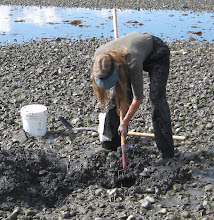In response to litigation filed against the U.S. Fish and Wildlife Service in U.S. District Court in Anchorage (Civil Case No.: 3:08-cv-00249-JWS) by environmental groups, Alaska Survival and Alaska Community Action on Toxics, Alaska Regional Director of the U.S. Fish and Wildlife, Geoffrey Haskett has issued an agency directive to halt use of herbicides on Alaska refuge lands.
In his January 13, 2009 directive, Haskett stated:
“The Refuge System in Alaska is hereby directed to immediately cease use of herbicides on or off refuges unless the requirements of NEPA, specific to the particular application, are met. That may include preparation of an environmental assessment ("EA") and finding of no significant impact ("FONSI"), if appropriate, or an environmental impact statement ("EIS") and record of decision ("ROD"), when required by NEPA.”
Alaska Survival and Alaska Community Action on Toxics, represented by attorney Paul H. Bratton of Talkeetna, filed suit in December, 2008 to enjoin the agency’s use of herbicides on the Kodiak National Wildlife Refuge, the Alaska Maritime National Wildlife Refuge and in the city of Kodiak. Fish & Wildlife has been spraying herbicides to kill orange hawkweed on Camp Island in the Kodiak National Wildlife Refuge since 2003 without complying with the National Environmental Policy Act. More recently, the agency has also begun to spray herbicides in other areas for other species of plants, such as Canada thistle and ox-eye daisy, which the agency considers to be “invasive”.
The chemicals used on the refuges include the herbicides Transline and Milestone VM, the surfactant Agri-Dex, and ACMI Violet Dye. Alaska Survival and Alaska Community Action on Toxics claim that these chemicals have the potential to cause adverse effects on humans, fish and wildlife. The environmental groups’ complaint states that no studies of the persistence and effects of these chemicals have been conducted in a northern environment similar to Alaska’s and therefore the effects of their use in Alaska is unknown.
“We don’t know what the effects on the Alaskan environment would be from these chemicals, how long they may last or how they may react in the sub-arctic,” said Judy Price of Alaska Survival. “We do know that when the University of Alaska researchers conducted research on herbicide spraying on the Alaska Railroad in the 80s, they found that the chemicals were lasting far longer than the scientific literature indicated, that they leached deeper than expected, and killed plants some distance from where the chemicals were sprayed, possibly moving out of the spray zone by tree root translocation.
It’s well known that herbicides persist longer in a cold climate, and that when they are around for these longer periods of time, they have more time to run-off to other areas, to leach into groundwater, to bioaccumulate in the soil and in animals’ bodies. But researchers are just discovering other troubling aspects of herbicide spraying in this environment. Just in the last few years, University researchers found that the herbicides sprayed on roadsides in Alaska, as a part of a DOT experiment, not only were still around the spring after the previous summer’s spraying, but that the herbicide concentration actually increased in surface soils. The researchers speculated that the herbicide was being released from the dead vegetation during spring thaw.”
Saturday, February 28, 2009
Subscribe to:
Comments (Atom)



